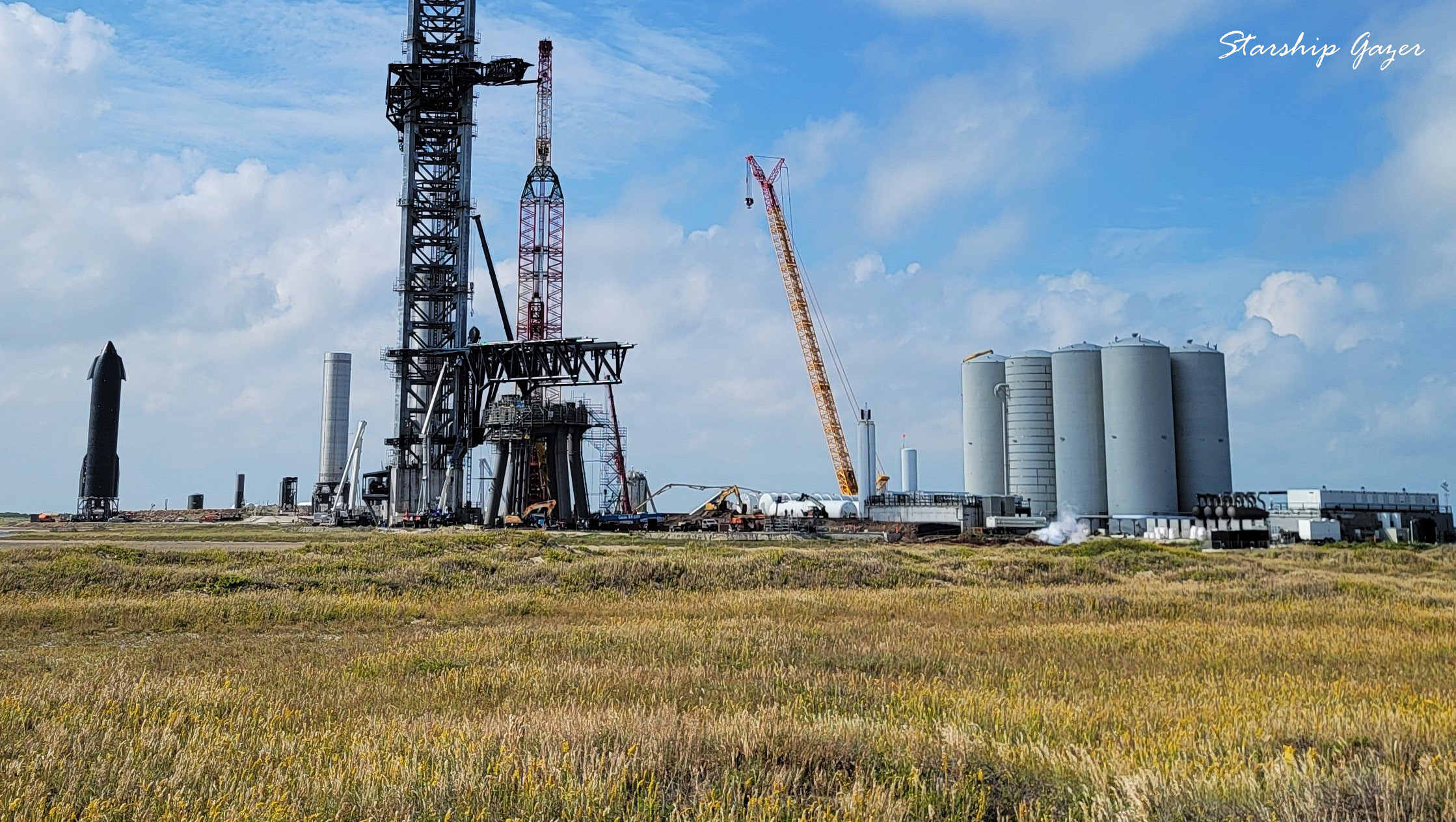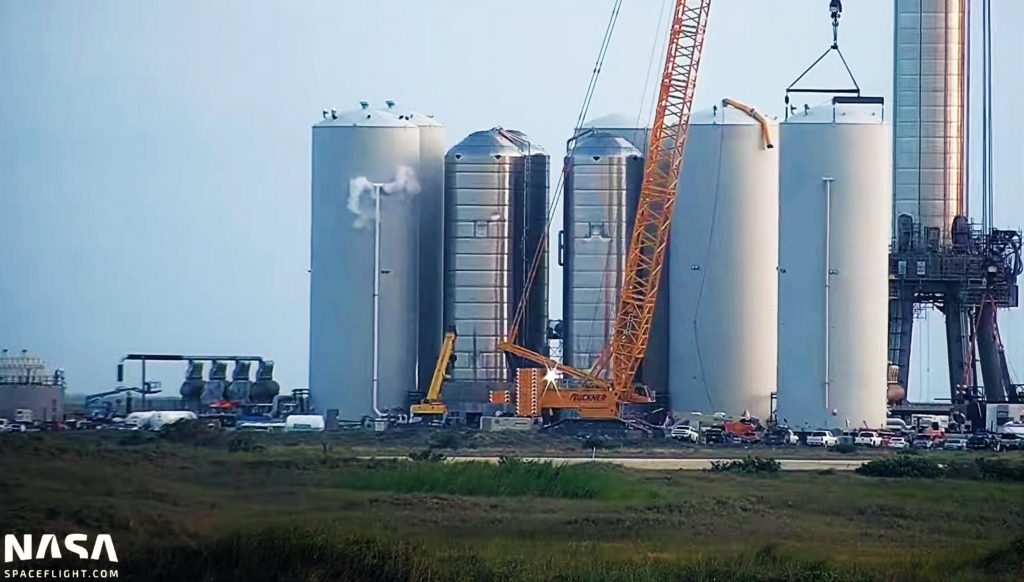

News
SpaceX begins filling Starship’s orbital launch site with rocket propellant
Less than a year after tank farm assembly began in South Texas, SpaceX has begun the painstaking process of filling Starship’s first orbital launch site with thousands of tons of rocket propellant.
Comprised of seven giant custom-built tanks, the last of which SpaceX installed and ‘sleeved’ in mid-October, Starbase’s first orbital-class tank farm is a bit like the pad’s circulatory system and needs to store, chill, and distribute all the propellant needed for a rocket launch. To support Starship and Super Heavy, both the largest individual rocket stages and the largest integrated rocket ever built, its launch site and tank farm have to be equally immense. In classic SpaceX fashion, the company has strived to keep the costs of that tank farm low and its speed of construction high, resulting in a setup that’s fairly unique as far as launch pads go.
Perhaps nothing emphasizes the scale of Starship’s first orbital-class tank farm than the process of filling it with the supercool propellant and fluids its designed to hold.
In mid-September, SpaceX began delivering cryogenic fluids to Starbase’s orbital tank farm for the first time ever. Instead of propellant, dozens of tanker trucks delivered liquid nitrogen to one or two of the farm’s tanks between mid-September and mid-October. Altogether, around 40-60 truckloads was delivered – only enough to partially fill one tank. That liquid nitrogen also appeared to be piped into two of the farm’s three liquid oxygen tanks, meaning that it may have only been used to clean and proof test them.
Combined, the farm’s seven main tanks should be able to store roughly 2400 tons (5.3M lb) of liquid methane (LCH4), 5400 tons (12M lb) of liquid oxygen (LOx), and 2600 tons (5.7M lb) of liquid nitrogen (LN2). LCH4 and LOx are Starship’s propellant, while LN2 is needed to ‘subcool’ that propellant below its boiling point, significantly increasing its density and the mass of propellant Starships can store.

In recent weeks, LN2 deliveries have picked back up at the orbital tank farm, suggesting that more tanks are being cleaned and proofed. SpaceX may have also begun filling one or both of the farm’s dedicated LN2 tanks, though it’s hard to say for sure. More importantly, around October 17th, SpaceX began filling Starship’s orbital tank farm with liquid oxygen – real propellant – for the first time. Rather than a slow and cautious process, deliveries have streamed in almost daily ever since. As of November 4th, at least 74 tanker trucks have delivered LOx to the farm in 18 days.
Based on Department of Transportation (DOT) regulations that limit the gross weight of cryogenic tanker trucks to about 37 tons (~81,000 lb), each of those trucks has likely delivered around 20 tons (~45,000 lb) of LOx to Starbase. Altogether, that amounts to around 1500 tons (3.3M lb) delivered in less than three weeks – enough to fill about 80% of one of the farm’s three LOx tanks or a quarter of its total LOx storage capacity.
Based on data from AI-based tracker Starbase Deliveries, which can only count daytime deliveries, at least 134 tankers have delivered LCH4, LOx, or LN2 to Starbase’s orbital and suborbital launch sites between October 4th and November 4th – an average of 4.3 per day. At that rate, even if every delivery went to the orbital pad, it would take SpaceX nearly four months just to fill the orbital tank farm. Put simply, the facilities and logistics required to support even a single orbital Starship launch are gargantuan.
News
Tesla begins Robotaxi certification push in Arizona: report
Tesla seems serious about expanding its Robotaxi service to several states in the coming months.

Tesla has initiated discussions with Arizona transportation regulators to certify its driverless Robotaxi service in the state, as per a recent report from Bloomberg News. The move follows Tesla’s launch of its Robotaxi pilot program in Austin, Texas, as well as CEO Elon Musk’s recent comments about the service’s expansion in the Bay Area.
The Arizona Department of Transportation confirmed to Bloomberg that Tesla has reached out to begin the certification process for autonomous ride-sharing operations in the state. While details remain limited, the outreach suggests that Tesla is serious about expanding its driverless Robotaxi service to several territories in the coming months.
The Arizona development comes as Tesla prepares to expand its service area in Austin this weekend, as per CEO Elon Musk in a post on X. Musk also stated that Tesla is targeting the San Francisco Bay Area as its next major market, with a potential launch “in a month or two,” pending regulatory approvals.
Tesla first launched its autonomous ride-hailing program on June 22 in Austin with a small fleet of Model Y vehicles, accompanied by a Tesla employee in the passenger seat to monitor safety. While still classified as a test, Musk has said the program will expand to about 1,000 vehicles in the coming months. Tesla will later upgrade its Robotaxi fleet with the Cyercab, a two-seater that is designed without a steering wheel.
Sightings of Cybercab castings around the Giga Texas complex suggests that Tesla may be ramping the initial trial production of the self-driving two-seater. Tesla, for its part, has noted in the past that volume production of the Cybercab is expected to start sometime next year.
In California, Tesla has already applied for a transportation charter-party carrier permit from the state’s Public Utilities Commission. The company is reportedly taking a phased approach to operating in California, with the Robotaxi service starting with pre-arranged rides for employees in vehicles with safety drivers.
News
Tesla sets November 6 date for 2025 Annual Shareholder Meeting
The automaker announced the date on Thursday in a Form 8-K.

Tesla has scheduled its 2025 annual shareholder meeting for November 6, addressing investor concerns that the company was nearing a legal deadline to hold the event.
The automaker announced the date on Thursday in a Form 8-K submitted to the United States Securities and Exchange Commission (SEC). The company also listed a new proposal submission deadline of July 31 for items to be included in the proxy statement.
Tesla’s announcement followed calls from a group of 27 shareholders, including the leaders of large public pension funds, which urged Tesla’s board to formally set the meeting date, as noted in a report from The Wall Street Journal.
The group noted that under Texas law, where Tesla is now incorporated, companies must hold annual meetings within 13 months of the last one if requested by shareholders. Tesla’s previous annual shareholder meeting was held on June 13, 2024, which placed the July 13 deadline in focus.
Tesla originally stated in its 2024 annual report that it would file its proxy statement by the end of April. However, an amended filing on April 30 indicated that the Board of Directors had not yet finalized a meeting date, at least at the time.
The April filing also confirmed that Tesla’s board had formed a special committee to evaluate certain matters related to CEO Elon Musk’s compensation plan. Musk’s CEO performance award remains at the center of a lengthy legal dispute in Delaware, Tesla’s former state of incorporation.
Due to the aftermath of Musk’s legal dispute about his compensation plan in Delaware, he has not been paid for his work at Tesla for several years. Musk, for his part, has noted that he is more concerned about his voting stake in Tesla than his actual salary.
At last year’s annual meeting, TSLA shareholders voted to reapprove Elon Musk’s compensation plan and ratified Tesla’s decision to relocate its legal domicile from Delaware to Texas.
Elon Musk
Grok coming to Tesla vehicles next week “at the latest:” Elon Musk
Grok’s rollout to Tesla vehicles is expected to begin next week at the latest.

Elon Musk announced on Thursday that Grok, the large language model developed by his startup xAI, will soon be available in Tesla vehicles. Grok’s rollout to Tesla vehicles is expected to begin next week at the latest, further deepening the ties between the two Elon Musk-led companies.
Tesla–xAI synergy
Musk confirmed the news on X shortly after livestreaming the release of Grok 4, xAI’s latest large language model. “Grok is coming to Tesla vehicles very soon. Next week at the latest,” Musk wrote in a post on social media platform X.
During the livestream, Musk and several members of the xAI team highlighted several upgrades to Grok 4’s voice capabilities and performance metrics, positioning the LLM as competitive with top-tier models from OpenAI and Google.
The in-vehicle integration of Grok marks a new chapter in Tesla’s AI development. While Tesla has long relied on in-house systems for autonomous driving and energy optimization, Grok’s integration would introduce conversational AI directly into its vehicles’ user experience. This integration could potentially improve customer interaction inside Tesla vehicles.
xAI and Tesla’s collaborative footprint
Grok’s upcoming rollout to Tesla vehicles adds to a growing business relationship between Tesla and xAI. Earlier this year, Tesla disclosed that it generated $198.3 million in revenue from commercial, consulting, and support agreements with xAI, as noted in a report from Bloomberg News. A large portion of that amount, however, came from the sale of Megapack energy storage systems to the artificial intelligence startup.
In July 2023, Musk polled X users about whether Tesla should invest $5 billion in xAI. While no formal investment has been made so far, 68% of poll participants voted yes, and Musk has since stated that the idea would be discussed with Tesla’s board.
-

 Elon Musk1 week ago
Elon Musk1 week agoTesla investors will be shocked by Jim Cramer’s latest assessment
-

 Elon Musk3 days ago
Elon Musk3 days agoElon Musk confirms Grok 4 launch on July 9 with livestream event
-

 Elon Musk14 hours ago
Elon Musk14 hours agoxAI launches Grok 4 with new $300/month SuperGrok Heavy subscription
-

 News7 days ago
News7 days agoTesla Model 3 ranks as the safest new car in Europe for 2025, per Euro NCAP tests
-

 Elon Musk2 weeks ago
Elon Musk2 weeks agoA Tesla just delivered itself to a customer autonomously, Elon Musk confirms
-

 Elon Musk1 week ago
Elon Musk1 week agoxAI’s Memphis data center receives air permit despite community criticism
-

 Elon Musk2 weeks ago
Elon Musk2 weeks agoTesla’s Omead Afshar, known as Elon Musk’s right-hand man, leaves company: reports
-

 News2 weeks ago
News2 weeks agoXiaomi CEO congratulates Tesla on first FSD delivery: “We have to continue learning!”

















